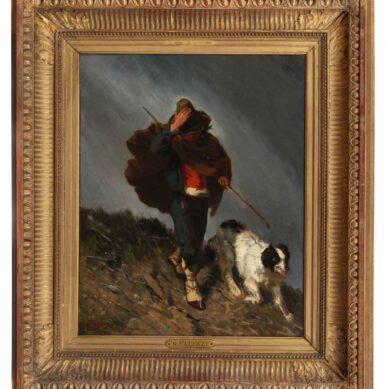You searched
Painter
Archimede Bresciani da Gazoldo
Are you interested in the sales or the purchase of his artworks?
We buy works of this artist
and of other painters and sculptors from the 16th century to the first half of the 20th century
The Berardi gallery offers a free and without obligation service for evaluation of ancient and modern art . To find your way in the art market, very complex and full of nuances, it is better to rely on a professional consultant who can answer fast and concretely to your needs. The clarity of the answers will resolve effectively the need to estimate or sell an asset.
Contact us immediately without commitment
Answers also in 24 hours:
Archimede Bresciani da Gazoldo
Archimede Bresciani da Gazoldo
Archimede Bresciani was born in 1881 in San Fermo di Gazoldo degli Ippoliti, a small village near Mantua. His humble family soon encouraged his artistic talents, which he showed during an early apprenticeship with a carpenter in a nearby village. Domenico Pesenti, a local painter and antiquarian, suggested that Archimede Bresciani deepen his talent and encouraged him to move to Milan to enrol at the Brera Academy.
At a very young age, barely seventeen, he came to Milan. To support himself, he continued to work as a carpenter, but once he came under the wing of Cesare Tallone at the Academy, he began to glimpse the hope of an artistic career. We are at the beginning of the 20th century and an elegant and culturally stimulating Milan welcomes the painter, who immediately settles in the worldly salons and adapts to a refined life, frequenting artists and writers, including Matilde Serao and Gabriele D’Annunzio.
Halfway between dandyism and a decadent attitude, Archimede Bresciani da Gazoldo – as he began to sign his name – was as interested in urban and nocturnal scenes as he was in the charm of the countryside where he grew up, initially rendered through the chromatic brilliance, evanescent outlines and plastic fluency he had learned from Tallone. But soon, he adhered to a Divisionism of clear segantinian matrix.
Divisionism: between nature and symbol
He made his debut in 1906 at the Milan Exhibition for the Sempione Tunnel with the Portrait of Countess O. and an Annunciation, while in 1910 he took part in the Venice Biennale for the first time with the Portrait of Marchesa R. C. and The Faithful. In the same year, with the Winter Evening presented at Brera, he was awarded the Mylius Prize, which definitively consecrated him to the critics and the general public.
Now, there is nothing impressionistic, immediate or spontaneous about Archimede Bresciani’s painting, as everything is carefully calibrated on the precise modulation of light, colour and composition, both in his naturalistic works, in which the mountain often appears imposing and unchanging, and in his figure paintings and those of a symbolic nature and literary evocation. The Divisionist technique, made up of long luminous filaments, is often accompanied by a pure and intense intimism, as can be seen in The Bridge of St George exhibited at the Roman Secession in 1914 and in Sunset in Engadine at the Biennale of the same year.
A personal and evocative Novecentismo
After the war, he returned to exhibit at the 1920 Venice Biennale, where he presented Bright sunrise and After dinner, and then held his first solo exhibition at the Galleria Pesaro in Milan. In the thirty-four works exhibited, one can fully read the dichotomy of Archimede Bresciani’s production: a mysterious Symbolist fascination and a rigorous and impeccable technique, which characterises the numerous portraits, but also his most significant works, including Segantini’s Tomb and the heartbreaking and Secessionist Waiting for the Hero. The Mother appeared at the Florentine Spring Exhibition in 1922 and a modern Mary Magdalene at the Venice Biennale in 1924.
At this point, Archimede Bresciani’s language gradually moved away from evocative Divisionism and towards a greater static and plastic definition of the figures, due to the birth of the Novecento and the need for a personal return to order. In any case, his production always remains shrouded by an intimate and fascinating veil of ambiguity and symbolism, as can be seen in the beautiful Saint Sebastian of 1931, but also in the Summer at Santa Rosa of the Florentine Union of 1933. In his later years, he returned to a sincere, late 19th-century naturalism, with peaks of light and a Cézanne-like handling of form and colour, which emerge from the tranquil country scenes painted in his birthplaces. Suffering from lung disease, he died at the age of just fifty-eight in 1939, after participating in the III Quadriennale in Rome with Mantuan rice field.
Elena Lago





